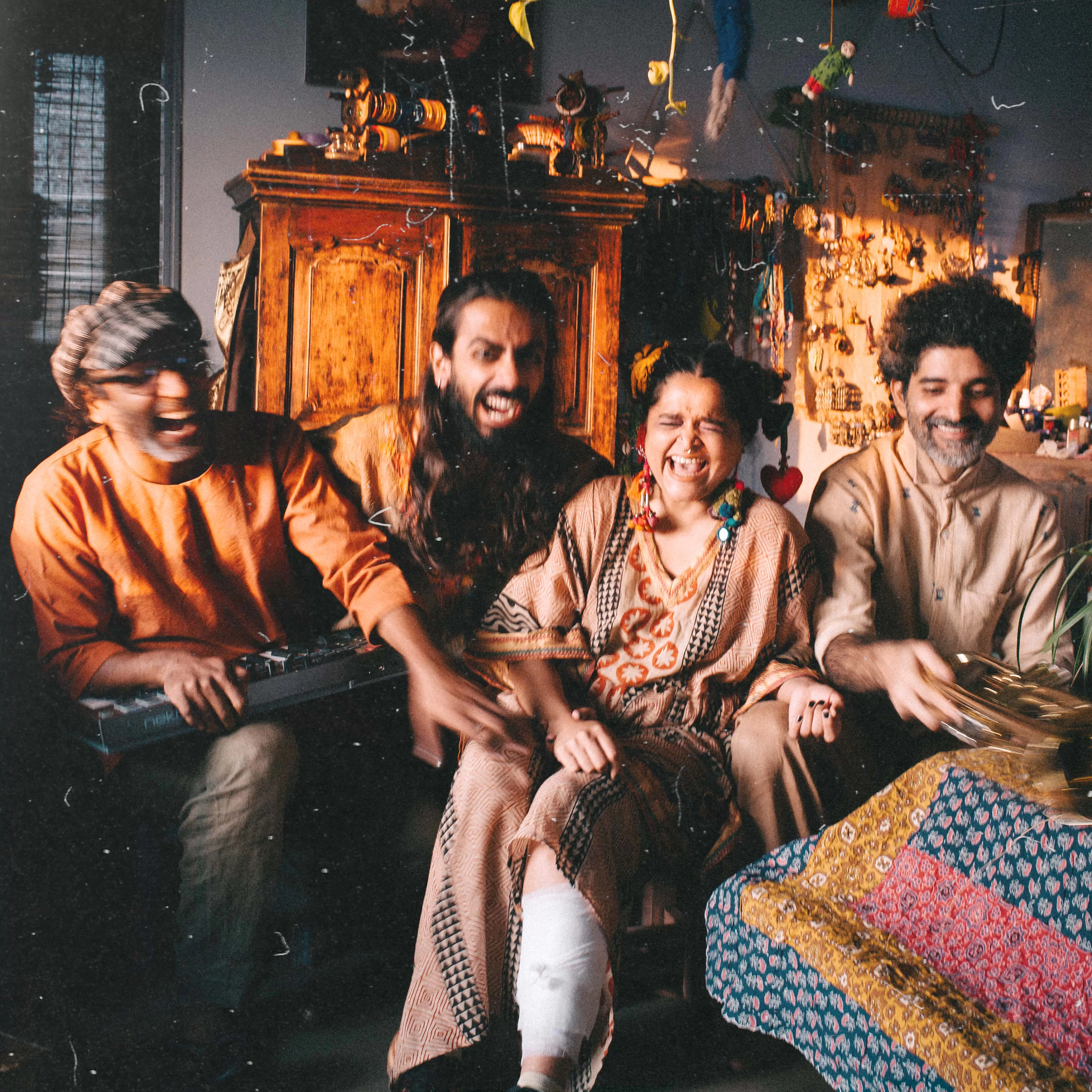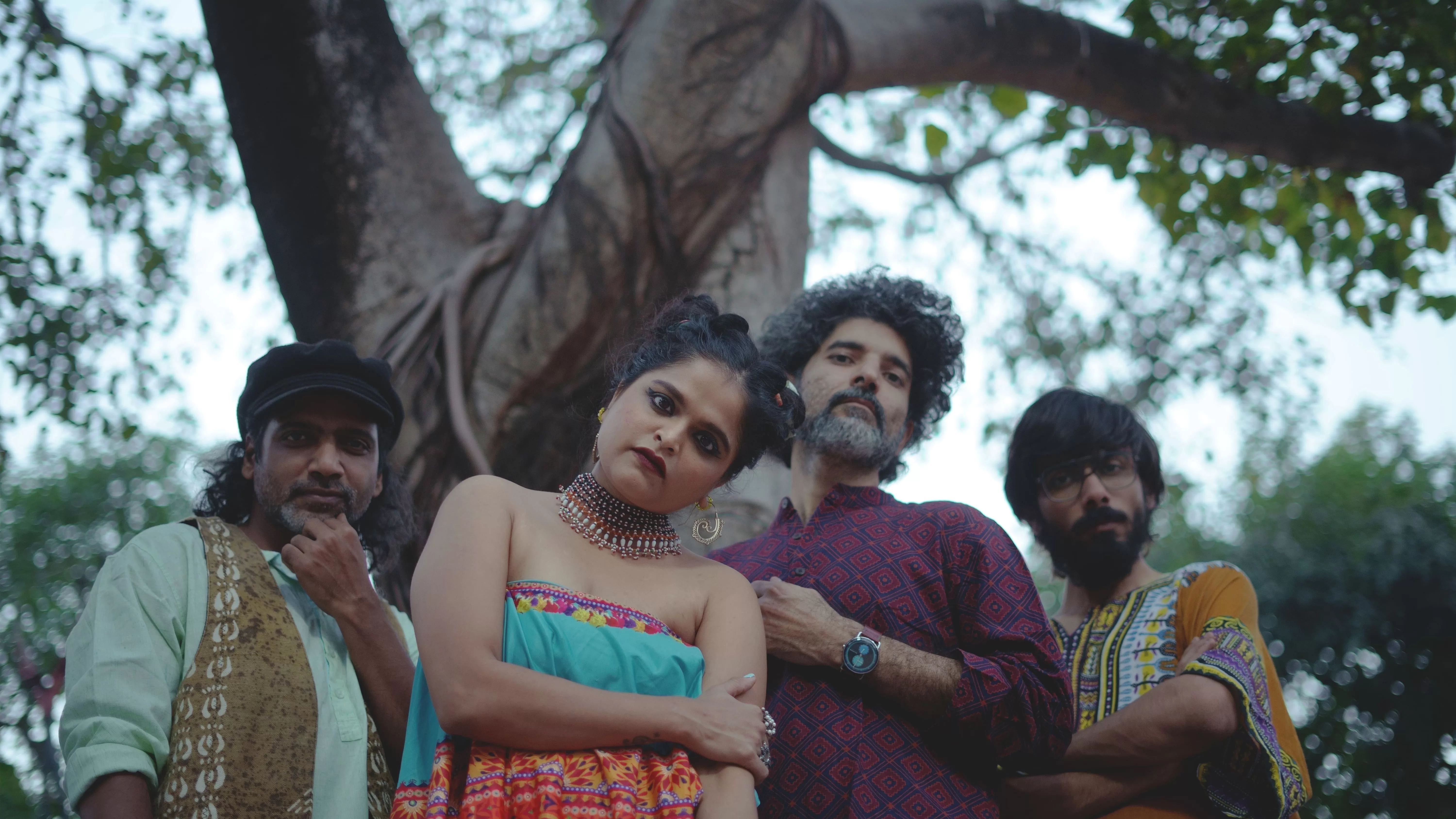Messages (Paigam) From The Mystics:
A conversation with The Tapi Project
By Aanchal Bordoloi; Edited by Sohaib Durrani
“You are the pearl in the necklace that is this world
But have you felt the thread that keeps you strung together?”
Mehsoos (Translated to English), by The Tapi Project
Grounded. I choose to use this word to describe my conversation with Yogendra or Yogi and Swati, from The Tapi Project. More than an interview, the 30 minute call felt like a wholesome conversation with a wise friend.

From left to right: Yogendra Saniawala (instruments, lyrics), Biju Nambiar (keyboards and bass guitar), Swati Minaxi (lead vocalist), & Gaurav Kapadia (drums)
The Tapi Project is a band based in Surat. The Hindu describes their music as slow-burn melodies with a mystic vibe. I find it challenging to put a pin on that. Their music, albeit a fusion of folk and contemporary music, uses elements from various genres such as Jazz and Trip-hop and adheres to no singular genre. It is in its essence, what the listener wants it to be, and a true embodiment to the testament of music containing no linguistic barriers.
It consists of Yogendra Saniawala (instruments, lyrics), Swati Minaxi (lead vocalist), Gaurav Kapadia (drums), and Biju Nambiar (keyboards and bass guitar). Here is a piece from our conversation yesterday:
The first impression that I got after listening to your music was that it wasn’t confined to any genre; it was fresh, unique, and robust with undertones of spirituality. Would you like to tell us a bit about how you like to present and perform your music?
Yogendra:
Travel and music brings us together, closer to reality and away from fantasies. I feel that as human beings, we are always stuck in between fantasy or nostalgia.
My experience with life and my struggles related to anxiety and depression, made me inquire and find the deeper essence of life and the nature of our being. All of this is reflected in our songwriting.
If you have listened to our song, Mehsoos, you would have heard these lines;
“moti tu, haar ye duniya,
dor ko tune,
mehsoos,
kiya kya?”
We want to convey that the universe lives within all of us. It is all about the first-hand experience. As Jiddu Krishnamurthi once said, truth is a pathless land. We have to walk our own paths. You cannot walk on somebody else’s path… otherwise it will be their truth, not yours. We have travelled extensively and all of this reflects in our music. We have songs about ego and the burning of it. We have a song about death. We want to invite our listeners to look inward and deeper into reality… but at the same time we also have fun!
If you see our stage act, I talk a lot of mumbo jumbo. Swati emanates spirituality with her vocals and vivid colours alone. All the styling, personality, and energy exuded by Swati is The Tapi Project personified. She is the face and visual identity of the band and I embody the audio, writing, and philosophy of the band. Biju and Gaurav complete us as the missing parts.
I do agree, when you talk about Swati embodying the visual elements in the band. I was watching the music video of Haiya Ho, and seamless was the word that came to mind.
Take this verse for instance,
Ho Ho jaala bhi gaaye haiya ho
Patvaar bhi gaaye haiya ho
Kuch panchi aaye haiya ho
Chal hum ud jaaye haiya ho
– Haiya Ho
The literal translation of which is:
The net too sings
The oars sing too
A few birds arrive
Let us take flight
The lyrics imply themes of liberation, upliftment, harmonious relationships between elements in nature, transcendence and unity. While I was watching the music video, what stood out for me was when you sang the word panchi, you emulated the flapping wings of a bird very effortlessly. There were also moments in the song where you interacted with the audience by giving them cues as if signalling them, when they could join in on the chorus. It seemed like a conversation.

I agree with us being caught up between fantasy and nostalgia. I am not sure if you’ve heard about the flow state – when you’re so immersed in what you’re doing that you lose track of time. Your music feels a lot like that.
There are two ways in which you can go about songwriting – one is when you’re hell-bent on writing a song… let’s say you want to write a Blues/Jazz song and the other is when you never want to write, but the song comes to you as an idea – maybe as poetry or a guitar riff. What you write… the melody is not written somewhere. It just comes from an unknown place. So we, in ourselves are an obstruction. We never want to write a song. The song arrives. When it arrives, the most important thing that can be done as an expressionist, is to not stand in its way. If your mindset is fixated on giving the song some direction in a certain way, then you can never create music which is absolutely flowing. In our case, we can’t do this. Fortunately, the rest of the band members are also in the same zone and when an idea arrives, we just react to each other and we’re never really looking at wanting to create a song.
For example, when we were writing our latest song which hasn’t been released yet, we were working on a background score for a film documentary. I remember how the song came about, we were sitting and practicing at Swati’s place which we also use as a studio. We were just about to leave. I was sitting with a harmonium, and the first few lines just came to me, and Swati was absolutely reluctant to sing the lines. But somehow within the next 15-20 minutes, we came up with a new song!
There’s this other song Tishnagi where I came up with a guitar riff, and Swati started singing it. We never plan for a song to happen. Things happen when you’re always in the state of flow.
If you listen to our songs, such as Mehsoos and Haiya Ho, the drums are polyrhythmic. I was playing a guitar riff, and Gaurav just came up with something using the Jazz brushes. For Haiya Ho as well, sometimes you can see him pick up the shaker. All of this is a reaction to the music, it’s not fixated in anything. This is the beauty of it. The rhythm is non-intrusive. Nobody else can play like Gaurav -with all the polyrhythm and syncopation, and still manage to keep it simple. Biju is great at harmonies and production. In Mehsoos, you can hear a lot of Biju’s work, which is brilliant. When it comes to harmonies, he doesn’t think of the 3rd and the 5th, he would think of the left or the centre harmony, which is not straightforward. He brings all these layers together and makes the sound very rich, complete and complex… and yet, simple.
You have already answered another question which was what your creative process looks like. This also provides some insight on how ideas and flashes of aha moments in the creative process emerge, coming from 4 individual band members.
We would love to hear about your musical influences and inspirations.
Swati : My favourite is The Tapi Project. I am inspired by my bandmates, since I spend the most amount of time with them.
Yogendra: Swati and I don’t really listen to a lot of new music anymore. In my case, it’s Radiohead. I also like the band Smile and Jonny Greenwood. At the moment, I listen to a lot of Dino Saluzzi, an Argentenian musician and Anouar Brahem from Tunisia and Joanna Brouk from the US. I like the silence between two notes – that’s where you can live.
I like the line “silence between two notes”. It reminds me of a quote from the movie ‘Maestro’ based on the American composer Leonard Bernstein –
“A work of art does not answer questions, it provokes them; and its essential meaning is in the tension between the contradictory answers”.
Yogendra: I do not consider myself a non-musician- we are all self-taught and we have managed to make a career in music. This comes from being true to yourself, and being honest with your very being.
If you could pick any musician/band that you would love to collaborate with (it could also be with legends who are no longer with us), who would they be?
Yogendra – Jonny Greenwood and Thom Yorke for me.
Swati – Björk and Ane Brun (Norwegian songwriter and guitarist)
Coming to 2025, what can we expect from the Tapi Project?
A few more releases. We just finished a tour in the UK and got in touch with Third Orchestra – which is not a normal western classical orchestra but an orchestra with musicians from all across the world. We are looking forward to our collaboration towards the end of the year; and also touring more and hopefully Womex (Worldwide Music Expo) in Finland.

To conclude, I believe Leonard Bernstein was right. This interview helped provoke more questions into the creative process and the very essence of our being. I remember when I was watching Swati’s ethereal performance of Haiyo Ho on Youtube, I was struck by a thought:
What if artists are mediums? What if there are several sources of energy in the universe that are filled with love? These little bursts of energy reach us through artists who act as mediums. A little far-fetched, I know. But to keep it simple, music does take us places, and yet helps to bring us closer to ourselves.
I follow Mark Manson’s work and he had introduced the concept of energy centres in one of his podcasts. This was in relation to people who have been diagnosed with PTSD (Post-Traumatic Stress Disorder) and have undergone stressful events. It was discussed that such people have energy centres within their bodies, which can be channeled and utilised in magnificent ways. For example, Nina Simone, the famous American singer-songwriter and pianist used music as a means to sing about the injustice brought forth by racial discrimination and oppression.
Coming back to what Yogendra kept circling back to during the interview – the here and the now, the balance between fantasy and nostalgia, the groundedness that traveling brings forth and coming back home to ourselves; it all fits perfectly with the band’s philosophy. This, in my opinion, is a hallmark of authenticity. I feel extremely grateful to have had such an enlightening conversation with Yogendra and Swati from The Tapi Project.